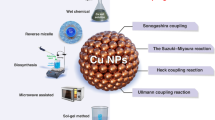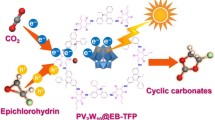Abstract
Two new silver-containing inorganic–organic hybrid compounds [Ag(2-MMIZ)2]6{[Ag(2-MMIZ)2]2[Ag(2-MMIZ)]2[AlW12O40]2} (1) and [Ag(2-MMIZ)2]5[AlW12O40] (2) based on Keggin polyoxometalates and Ag complex have been successfully synthesized by reaction of AgNO3, 2-MMIZ (2-methylimidazole), and the α-Na5[AlW12O40]·13H2O precursor under hydrothermal conditions, and these two compounds were well characterized by elemental analyses, IR spectrum, UV–Vis spectrum, Thermogravimetric analyses, Powder X-ray diffraction measurements and single-crystal X-ray diffraction. The structure of Compound 1 represents the first dimer anion {[Ag(2-MMIZ)2]2[Ag(2-MMIZ)]2[AlW12O40]2}6− and six free [Ag(2-MMIZ)2]+ segments as cations, among the five crystallographically independent of [Ag(2-MMIZ)] segments in 1, Ag atoms exist three types of coordination configurations including linear, triangular and T type. Compound 2 is composed of one α-Keggin polyoxoanion [AlW12O40]5− and five free [Ag(2-MMIZ)2]+ segments as cations, there is only a linear coordination mode of Ag atoms in 2. Compounds 1 and 2 show photocatalytic activity for degradation of organic dye Rhodamine-B.
Graphical Abstract
The first dimmer anion {[Ag(2-MMIZ)2]2[Ag(2-MMIZ)]2[AlW12O40]2}6− based on [Ag(2-MMIZ)]+ cations, [Ag(2-MMIZ)2]+ cations and [AlW12O40]5− polyoxoanions can be used for degradation of organic dye Rhodamine-B.






Similar content being viewed by others
References
M. T. Pope Heteropoly and Isopoly Oxometalates (Springer, Berlin, 1983).
M. T. Pope and A. Müller (1991). Angew. Chem. Int. Ed. 30, 34.
N. Mizuno and M. Misono (1998). Chem. Rev. 98, 199.
J. T. Rhule, C. L. Hill, and D. A. Judd (1998). Chem. Rev. 98, 327.
E. Coronado and C. J. Gómez-García (1998). Chem. Rev. 98, 273.
P. Gouzerh and A. Proust (1998). Chem. Rev. 98, 77.
J. Zhang, J. Hao, Y. G. Wei, F. P. Xiao, P. C. Yin, and L. S. Wang (2010). J. Am. Chem. Soc. 132, 14.
E. F. Wilson, H. N. Miras, M. H. Rosnes, and L. Cronin (2011). Angew. Chem. Int. Ed. 50, 3720.
I. A. Weinstock, J. J. Cowan, Elena M. G. Barbuzzi, H. D. Zeng and C. L. Hill (1999). J. Chem. Soc. 121, 4608.
J. Q. Sha, J. Peng, Y. Q. Lan, Z. M. Su, H. J. Pang, A. X. Tian, P. P. Zhang, and M. Zhu (2008). Inorg. Chem. 47, 5145.
H. I. S. Nogueira, F. A. AlmeidaPaz, P. A. F. Teixeira, and J. Klinowski (2006). J. Chem. Commun. 28, 2953.
H. J. Pang, J. Peng, J. Q. Sha, A. X. Tian, P. P. Zhang, Y. Chen, and M. Zhu (2009). Mol. Struct. 921, 289.
M. Zhu, P. Chen, and M. Liu (2011). ACS Nano. 5, 4529.
S. J. Li, S. M. Liu, S. X. Liu, Y. W. Liu, Q. Tang, Z. Shi, S. X. Ouyang, and J. H. Ye (2012). J. Am. Chem. Soc. 134, 19716.
N. Kakuta, N. Goto, H. Ohkita, and T. Mizushima (1999). J. Phys. Chem. B. 103, 5917.
G. C. Lica, K. P. Browne, and Y. Y. Tong (2006). J. Chem. Soc. 17, 349.
R. J. Liu, S. W. Li, X. L. Yu, G. J. Zhang, Y. Ma, and J. N. Yao (2011). J. Mater. Chem. 21, 14917.
T. McGlone, C. Streb, M. B. Fité, J. Yan, D. Gabb, D. L. Long, and L. Cronin (2011). Cryst. Growth Des. 11, 2471.
C. Streb, C. Ritchie, D. L. Long, P. Kgerler, and L. Cronin (2007). Angew. Chem. Int. Ed. 119, 7723.
G. G. Gao, P. S. Cheng, and T. C. W. Mak (2009). J. Am. Chem. Soc. 51, 18257.
C. Streb, R. Tsunashima, D. A. MacLaren, T. McGlone, T. Akutagawa, T. Nakamura, A. Scandurra, B. Pignataro, N. Gadegaard, and L. Cronin (2009). Angew. Chem. Int. Ed. 48, 490.
Y. Kikukawa, Y. Kuroda, K. Yamaguchi, and N. Mizuno (2012). Angew. Chem. Int. Ed. 51, 2434.
X. L. Zhao and T. C. W. Mak (2010). Inorg. Chem. 49, 3676.
D. B. Dang, Y. N. Zheng, Y. Bai, X. Y. Guo, P. T. Ma, and J. Y. Niu (2012). Cryst. Growth. 12, 385.
G. Y. Luan, Y. G. Li, S. T. Wang, E. B. Wang, Z. B. Han, C. W. Hu, N. H. Hu, and H. Q. Jia (2003). Dalton Trans. 233. doi:10.1039/B208531C.
N. F. M. Henry and K. Lonsdale (eds.) International Tables for X-ray Crystallography (Kynoch Press, Birmingham, 1952).
G. M. Sheldrick SHELXS-97: Programs for Crystal Structure Solution (University of Göttingen, Göttingen, 1997).
Oa is the oxygen atom bond to the Al atom, Ob is the bridging oxygen atom shared by two W atoms from different W3O13 clusters, Oc is the bridging oxygen atom shared by two W atoms from the same W3O13 cluster, and Od is the terminal oxygen atom combined with only one W atom.
I. D. Brown and D. Altermatt (1985). Acta Crystallogr. Sect. B. 41, 244.
S. T. Zheng, J. Zhang, J. M. C. Juan, D. Q. Yuan, and G. Y. Yang (2009). Angew. Chem. Int. Ed. 48, 7176.
B. Gordin, J. Vaissermann, P. Herson, L. Ruhlmann, M. Verdaguer and P. Gouzerh (2005). Chem. Commun. 5624. doi:10.1039/B510434C.
L. Han, P. P. Zhang, H. S. Liu, H. J. Pang, Y. Chen, and J. Peng (2010). J. Chem. Soc. 21, 81.
P. P. Zhang, J. Peng, H. J. Pang, J. Q. Sha, M. Zhu, D. D. Wang, M. G. Liu, and Z. M. Su (2011). Cryst. Growth Des. 11, 2736.
Acknowledgments
This work was supported by the NNSF of China (Grant 21171030); NSF of Heilongjiang Province (B201012); NSF of Daqing Normal University (11ZR02) and Doctoral Scientific Research Foundation of Daqing Normal University (09ZB01).
Author information
Authors and Affiliations
Corresponding author
Electronic Supplementary Material
Below is the link to the electronic supplementary material.
Rights and permissions
About this article
Cite this article
He, DF., Liu, HS., Ci, CG. et al. Hydrothermal Synthesis, Structures and Properties of Two Silver-Containing Organic–Inorganic Hybrids Based on Precursor [AlW12O40]5− . J Clust Sci 26, 1557–1566 (2015). https://doi.org/10.1007/s10876-015-0850-5
Received:
Published:
Issue Date:
DOI: https://doi.org/10.1007/s10876-015-0850-5




